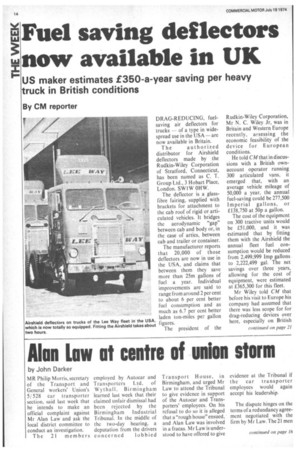Fuel saving deflectors now available in UK
Page 16

Page 23

If you've noticed an error in this article please click here to report it so we can fix it.
US maker estimates f350-a-year saving per heavy truck in British conditions
By CM reporter
DRAG-REDUCING, fuelsaving air deflectors for trucks — of a type in widespread use in the USA —are now available in Britain.
The authorized distributor for Airshield deflectors made by the Rudkin-Wiley Corporation of Stratford, Connecticut, has been named as C. T. Group Ltd., 3 Hobart Place, London. SW I W OHW.
The deflector is a glassfibre fairing, supplied with brackets for attachment to the cab roof of rigid or articulated vehicles. It bridges the aerodynamic "gap" between cab and body or, in the case of artics, between cab and trailer or container.
The manufacturer reports that 20,000 of those deflectors are now in use in the USA, and claims that between them they save more than 25m gallons of fuel a year. Individual improvements are said to range from around 2 per cent to about 6 per cent better fuel consumption and as much as 6.7 per cent better laden ton-miles per gallon figures.
The president of the Rudkin-Wiley Corporation, Mr N. C. Wiley Jr, was in Britain and Western Europe recently, assessing the economic feasibility of the device for European conditions.
He told CM that in discussions with a British ownaccount operator running 300 articulated vans, it emerged that, with an average vehicle mileage of 50,000 a year, the annual fuel-saving could be 277,500 Imperial gallons, or £138,750 at 50p a gallon.
The cost of the equipment on 300 tractive units would be £51,000, and it was estimated that by fitting them with the Airshield the annual fleet fuel consumption would be reduced from 2,499,999 Imp gallons to 2,222,499 gal. The net savings over three years, allowing for the cost of equipment, were estimated at £365,300 for this fleet.
Mr Wiley told CM that before his visit to Europe his company had assumed that there was less scope for for drag-reducing devices over here, especially on British
continued from page 14
roads. But he was pleasantly surprised to find that British motorways were every bit as advanced as those in the USA and that traffic was operating at an average of 10 to 15mph faster than in the US. This, combined with higher fuel costs, made dragreduction systems very advantageous to British operators.
The whole problem of _ aerodynamic drag in trucks had, he said, been the subject of study by the US Trucking Industry for some years and the first analytical work had been done under the auspices of the American Trucking Association at the University of Maryland in 1954. Generally it was found that by various fairing techniques between tractor and trailer, the aerodynamic drag coefficient could be reduced over 30 per cent. However, fairings of the type required would interfere with articulation of the vehicle.
Added Mr Wiley: "It was not until 1963 that aerodynamicist Or W. S. Saunders invented a practical way to accomplish the same effect by use of what has now become the A irshield wind deflector. This unit causes the oncoming airstream to 'jump the gap' and re-attach. smoothly to the top and sides of the trailer or box of a rigid chassis truck. The con cept is patented in the US and various foreign countries including the UK, patent No. 341622."
The reduction in drag by use of a wind deflector and a vortex stabilizer is said to be such as to reduce power requirement on a heavy truck by between 20 and 30bhp at 55mph.








































































































